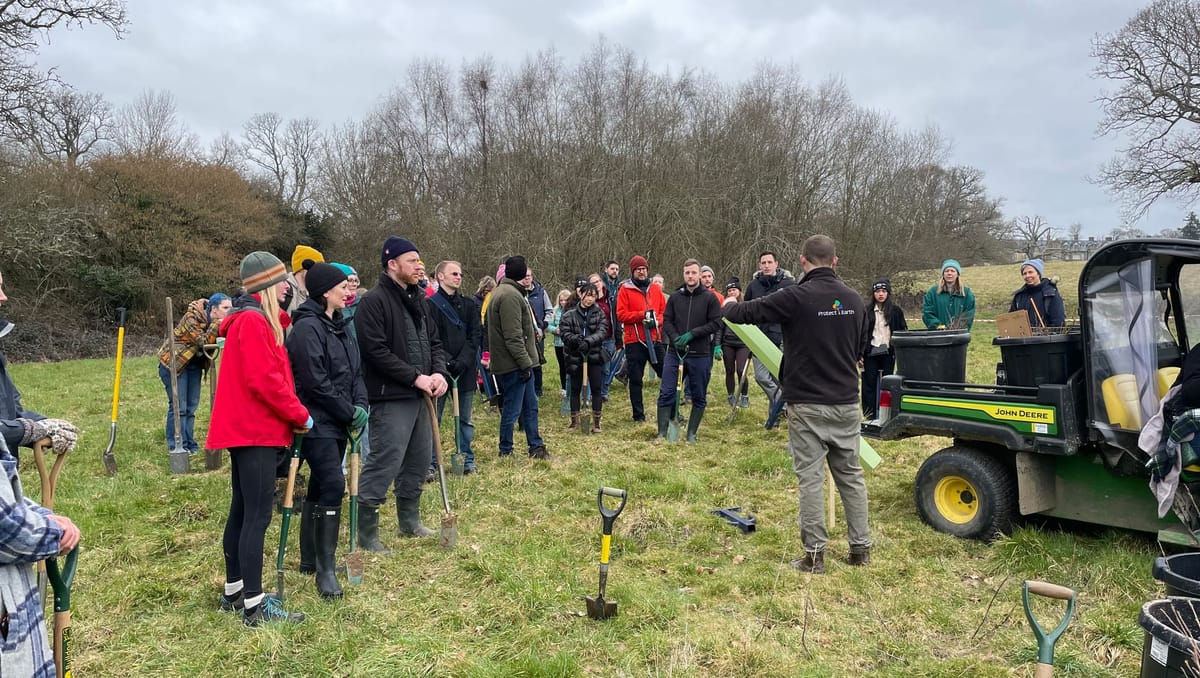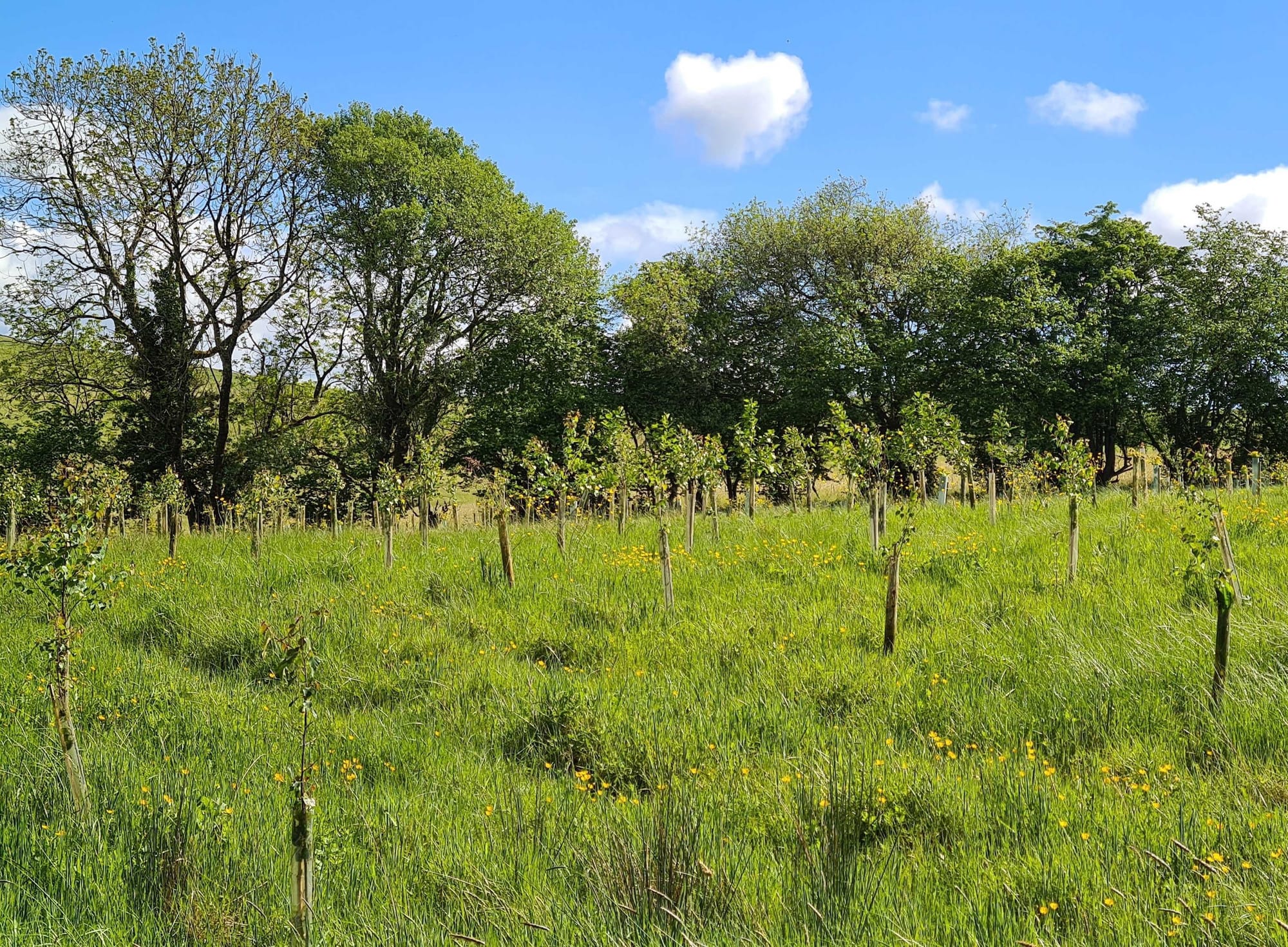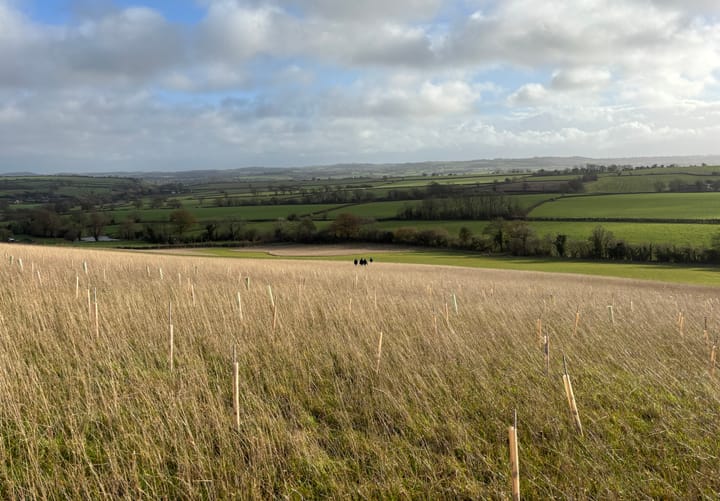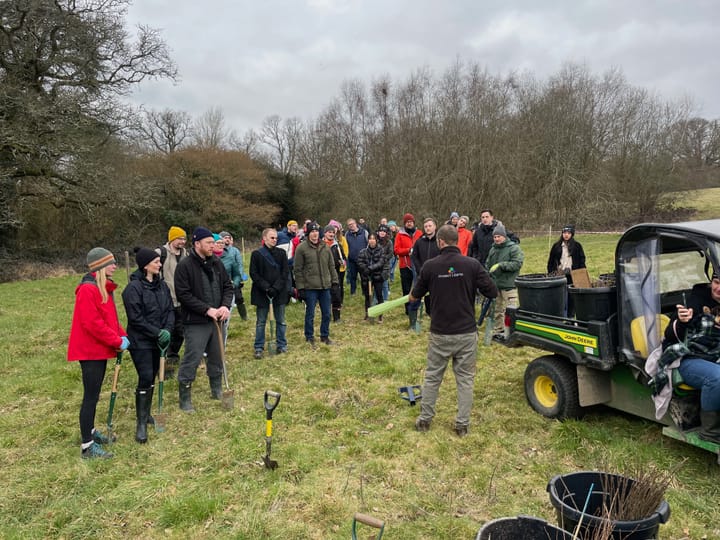The Best Possible Quality Tree Planting
Attempting to end the infighting on tree planting vs natural regeneration so we can all focus on getting on the critical job of doing loads of both, and when we are planting, let's do it properly.

Discussions around “tree planting” versus “natural regeneration” regularly pop up online, and it’s amazing to see more people getting interested in this previously rather obscure conversation. Campaigners have done an amazing job of getting natural regeneration supported by government grant systems such as English Woodland Creation Offer, making this possible (and profitable) for more land owners, so we’ll see more of it happening across the country. At the same time some of the conversations are pretty unscientific, with suggestions of “tree planting is bad” when people are really just referring to problems that occur through “bad tree planting”, and natural regeneration is hailed a silver bullet by some activists when the vast majority of experts will explain it is far more complicated than that.
Instead of getting into a fist fight, let’s talk about what natural regeneration is, when to use it, when to use tree planting, and how to do the best quality tree planting possible to avoid any of the problems people talk about when they complain about tree planting for natural woodlands.
Most of us know what tree planting is, but let’s establish a clear basis for comparison. Some people refer to all tree planting as “plantations”, then others hear the word plantation and think of the worst examples of non-native conifer plantations, which when done poorly are barren lifeless deserts, with no understory, minimal habitats, and almost no value to wildlife. This is not all timber plantations, but that’s another topic for another day. In this article we’re talking about tree planting for creating native woodlands, not timber plantations.
Natural regeneration means letting land that used to be woodland re-establish itself. This is fantastic in areas like timber plantations on ancient woodlands that have had all their native species cut down, but still have an amazing store of seeds in the soil. This is what we’re doing at High Wood, taking out non-native conifers and letting the native species come back, where most of the land will not require any planting at all, and it will be full of silver birch, oak, ash, holly, hazel, rowan, and whatever else is still in the soil from before, along with whatever turns up via birds and wind spreading other seeds from nearby.

Natural colonisation is another term which gets mixed in with natural regeneration, but they’re a little different. This means land which was never wooded, or has not been woodland for a long time. For example a woodland that was felled and converted to farmland decades or centuries ago. Seeds will spread from nearby seed sources such as woodlands and hedgerows, being dropped nearby by gravity, being buried or dropped by birds and mammals, and carried further by the wind, and suckering from adventitious roots. This method involves going through the full “woodland succession” process of scrubland generating from bramble and gorse, then “pioneer species” like rowan and willow growing through the protection, creating bird perches to attract more birds, then more diverse species being dropped into the bramble which over time grow through the pioneer species to make a diverse wonderful woodland. This is ideal, and the more seed source there is nearby the better and quicker it goes.

There are no silver bullets here, and none of these approaches to woodland creation are inherently bad, unless done poorly, in the wrong place. You’ve heard “the right tree, in the right place” and sometimes that means not planting somewhere just as much as it means stalling natural colonisation / succession where an existing habitat is already valuable. It’s complicated, but a lot of experts have taken a swing at making it simple to understand.

Ignoring the fact that it mentions using NFTs (which are generally scams and nonsense) there’s nothing much to disagree with here, other than the fact that 5 and 6 are “or”. At Protect Earth not only are we using all three approaches on different sites, we generally combine approaches to provide the best possible outcomes.
Woodland Succession Has Begun
Our site in Lloyney, Powys is 30% natural colonisation and 30% planting, because a huge chunk of it is already well on its way to being an interesting mix of habitats. We can plant up the areas that have been grazed to the dirt for decades, and leave the areas of regen alone.
In areas where gorse and bramble are already taken hold, the last thing you want to do is cut that all down and start planting. That’s been known to happen, but please never ever do this. If you’ve got loads of bramble and gorse you’ve got a young woodland, just keep doing absolutely nothing and you’ll have a mature woodland.
Species Reintroduction
Some locations will have seeds in the soil or seeds nearby, but the woodland creation will be limited to what seeds are available, and this might not be the diverse mix of species we want for the new woodland.
Bolstering biodiversity through introducing species that used to be in the area, or should be in the area, can just mean dotting some of these trees around, or it could mean planting 25-50% of the land with a mixture of species that aren’t there and leaving large spacing and clearings between the planted saplings for nature to fill in the gaps.

This is one of the most common versions of “both” for us, but my favourite examples would be adding Plymouth Pear and Cornish Elm around High Wood, two species that are incredibly rare, and would almost certainly never have turned up by themselves any time in the next 100 years.

Another example: Restoring Hardknott Forest. They are restoring 630 hectares of old conifer timber plantation, and whilst regeneration was doing a great job, it was missing a few species, so for the sake of biodiversity and creating a functional ecosystem some supplementary planting of Juniper, Hawthorn, and Hazel was needed.

This practice is not just my favourite approach, but it’s recommended by Rewilding Britain who are some of the most popular proponents of the natural regeneration & colonisation methods.
There’s a whole lot more academic material out there on when to use one or the other, like this fantastic study, but it’s pretty fair to say the reforestation community is in agreement that tree planting pays a large part in reforestation going forwards, and nobody out there thinks it’s inherently a bad thing to do for carbon or wildlife unless you’re doing something very silly.
Whether a particular location needs entirely tree planting, or partially tree planting, there are a few golden rules that we stick to to make sure we’re creating the best possible outcomes, and not doing any of the problematic things that pop up in the media.
Doing Tree Planting Right
Over the years we’ve refined our approach to ensure we’re doing the best quality tree planting possible, but some of this is just plain obvious stuff that nobody has done for decades yet still comes up in articles all the time.
Never plant trees in peat bogs
Since the second world war, and again in the 1980’s there was a rapid expansion of conifer planting all over the UK, with sitka spruce getting jammed into every bit of spare land possible, ignorant or uncaring of the impacts to wildlife and carbon. Tree planting in a peat bog will release more carbon dioxide than the trees could ever hope to sequester, turning one of our best carbon sinks into a carbon source.
Most of those 80’s conifer plantations have been harvested now, or will be soon, and in many cases the peatland is being restored to turn it into a carbon sink once again.
Is this mistake still being made? Yes and no. If you want government grants, or it is larger than a few hectares, you’ll need approval from the Forestry Commission, and they no longer permit planting in deep peat (>50cm). You simply can’t do that. Shallow peat is permitted, but as a rule we will not take on planting like that, on our own land or for anyone else, even if we could.
If we had land with degraded peat we’d be working on restoring the peat, and if you have land with degraded peat you should get in touch so we can work on that for you
Never replace wildflower meadows with woodland
Wildflower meadows are a semi-man made habitat that requires constant management and grazing to maintain. This could mean introducing grazing animals at a certain time of year, or cutting and removing the grass to use as hay.
This service used to be performed by wild grazers wandering around the countryside in small numbers, but due to fencing, species extinctions, development, and grasslands being converted to “improved grassland” monocultures on non-native grass species for intensive grazing, 97% of our wildflower meadows have been lost.
Whenever possible we introduce wildflower meadow area to our sites. For example, there was an area at Goytre Wood we’d intended to plant, but discussions with the community highlighted that is where the kids like to sledge in winter, and that would make a perfect location for a wildflower meadow.
Wildflower meadows sequester a lot more carbon than you might think, and whilst the sequestration rates might not be as much as a woodland, it’s not just about carbon. Semi/natural grasslands and wildflower meadows are horrendously rare, and species that have specialised to rely on them are struggling. Therefore even if the carbon sequestration rates are not quite as high, we need to remember that we are fighting both the climate and biodiversity crises, and it’s important to never do anything that would benefit one at the cost of the other.

Create a mosaic of habitats
It’s often been suggested that a benefit that natural colonisation has over tree planting is the random nature of woodland succession allows for a variety of habitats to form: with glades developing, dead wood, bare earth, habitat piles, varied grass swards, varying density of scrub and canopy structures.
This is true, left to its devices natural colonisation will of course be far more varied than a team whacking a bunch of saplings in a grid with rigid groupings of saplings, but those are not the only two options that exist.
Our ecologist is involved not just in the planning of a woodland, but is there on the actual planting day, putting out coloured bamboo canes that line up to species, so our planters can match each specific cane to a specific sapling, allowing a “paint by numbers” approach to creating these critical and complex structures.
We’ve created hazel groves lines with a ring of oaks. We’ve left meadow sections in the planting. We’ve varied density across different parts of a site. We’ve planted soft woodland edges. We’ve created dead wood and habitat piles from existing nearby wood, and in more mature stands we’ve thinned and ring-barked trees to provide dead wood, both standing and on the forest floor.
Certainly this is not how every single reforestation project is going to work, but we know plenty of organisations who do work in this way, and encourage others to try it when grants allow for that level of flexibility.
Never import anything from abroad
In the past huge numbers of saplings were imported from abroad, which in hindsight was an incredibly bad idea. Our biosecurity has suffered, with multiple pests, fungi, and diseases being brought over in the living biomatter and soil. This is how Ash Dieback made it to the UK, and the threat of further diseases is something we all need to be wary of.
Many of these pests and diseases are actually brought in on imported timber, another reason why we need to be expanding sustainable timber production in the UK, but that’s a discussion for the forestry industry to have. For those of us in the conservation woodland space, we need to reject any saplings grown outside of the U.K. We also need to make sure we’re rejecting any saplings that are grown in the UK but sourced from foreign seed.
Sourcing saplings from quality nurseries around the country is simple, and not only avoids bringing new diseases onto our shores, but has other benefits. All over the UK there are subregions where the genetics within a certain species are slightly different, with minor specialisations helping that species to thrive in the particular conditions of that area. After all, Ceredigion and Yorkshire are not the same, and using the same saplings in both just doesn’t make sense. By getting the right “seed provenance” we can increase survival rates, and reduce how far our saplings are moving around, reducing the chances of moving any diseases around within the country.
Learn more about how Protect Earth source our saplings.
Support community nurseries that collect local seed
Community tree nurseries have been around for a while, and more and more are starting to appear. Charities and organisations like Moor Trees, ForUsTree, More Trees BANES, are going out seed collecting with volunteers, gathering seeds from ancient and semi-natural woodlands. They’re close enough that the chance of spreading disease around the country is negligible, but far enough away that the seeds may not have made it there through natural methods alone.
These seeds are then grown at the community run nurseries, on their land, other charity land, schools, etc., and when they’re ready they’re sold on to groups like ourselves who do not have our own nurseries, but do have access to land that needs planting.
Using community nurseries ticks every box for us.
- Supporting other charities.
- Putting money into the local economy of wherever we are planting.
- Minimising biosecurity threats.
- Using the best possible seed provenance.
If you are starting a community nursery, or would be interested in running one on any of our land, please get in touch.
Keep Experimenting with Sustainable Guards
Back in May 2021 I wrote that plastic tree guards were still a sad necessity for so many tree planting projects, but hoped that the 2021/22 planting season would be the end of that as so many sustainable tree guards were starting to pop up. We experimented with all of them, getting free samples from some companies, buying thousands of each of the others. Sadly most of them are the unfortunate combination of expensive and bad.
Cardboard guards seemed like the most interesting, because most bioplastic is still plastic, and still problematic. Sadly on the three sites where cardboard guards were trialled, the deer ate ~50% of the trees, right through the guards, all within a few months of planting them. Replacing thousands of saplings and buying thousands of new guards stretched our budgets pretty thin, and delayed the success of the woodlands, delaying the carbon sequestration and much needed habitat from establishing.
The biodegradable plastic rabbit spirals we’ve used at several sites turn out to be only “industrially compostable”, meaning they need to be collected and sent off to a specialist. All the spirals that break down in place will take centuries to degrade, because they break into small pieces (many were even chewed apart by rabbits) and it’s impossible to collect those fragmented plastic pieces that have been blown off into a hedge or squashed into the soil.

The best sustainable guards we’ve tried are Vigilis Bio shelters, which are a form of bioplastic which will apparently break down in the soil leaving no microplastics, but we only got a handful to trial and they’re not commercially available. There’s also the plastic-free guards from NextGen Tree Shelters made out of wool, and I’ve been eager to get hold of these since they were announced years ago, but they’ve been saying “available next season” for years.
Whilst we wait for NextGen Tree Shelters or Vigilis Bio shelters, to hit the market, the very best tree guards to use remain to be the only ones that are definitely not going to fall apart, that can be collected up and recycled, and that, for now, as much as we hate it, are fossil plastic guards. Specifically we use Tree Defender Pro for any sites with too many deer, and deer fencing for any sites which can get the funding for them.
We will recycle every single one of our tree guards, and if you have a woodland creation project with trees that have outgrown their guards but you’re not a spring chicken or don’t have the time to collect them up, we’ll happily collect yours and get them recycled too. Please get in touch and we can help get the plastic out of your woodland.
Summary
For any given site there is a decision flow, which decides which parts of which sites would be best served by using tree planting, natural colonisation, or a combination of both. Then for any parts using tree planting we use locally sourced and locally grown saplings, designing a mixture of habitats to favour a wide variety of wildlife, whilst digging scrapes and ponds, to improve water retention and further increase wildlife.
When a woodland has matured enough we pop up bird boxes, bat boxes, dormice boxes, owl boxes, to further assist these struggling species, fully remove any plastic and waste, and from there we can keep an eye on any wildflower species which are not showing up in the meadows or woodlands and introduce them ourselves.
At Protect Earth we believe that continuing to focus on the quality of our tree planting, we can shift the debate from “tree planting is bad”, or “natural regeneration is better” which all seems like a unconstructive and problematic conversation to be having when the UK has been failing to hit reforestation targets since they were set, despite shrinking them…
Instead we want to focus on something we can all agree with, from hobbyists to experts: bad tree planting is bad, so let’s call it out and suggest improvements, outlaw bad practices, and try to elevate the whole practice as we go. Let’s do loads more good tree planting, and let’s do even more natural regeneration and colonisation.

Plant a U.K. tree or metre of hedgerow
Whether you like the idea of planting trees or not, the Climate Change Comittee say we need another 200,000km of hedgerow, and you can help Protect Earth by sponsoring one meter at a time.



Comments ()